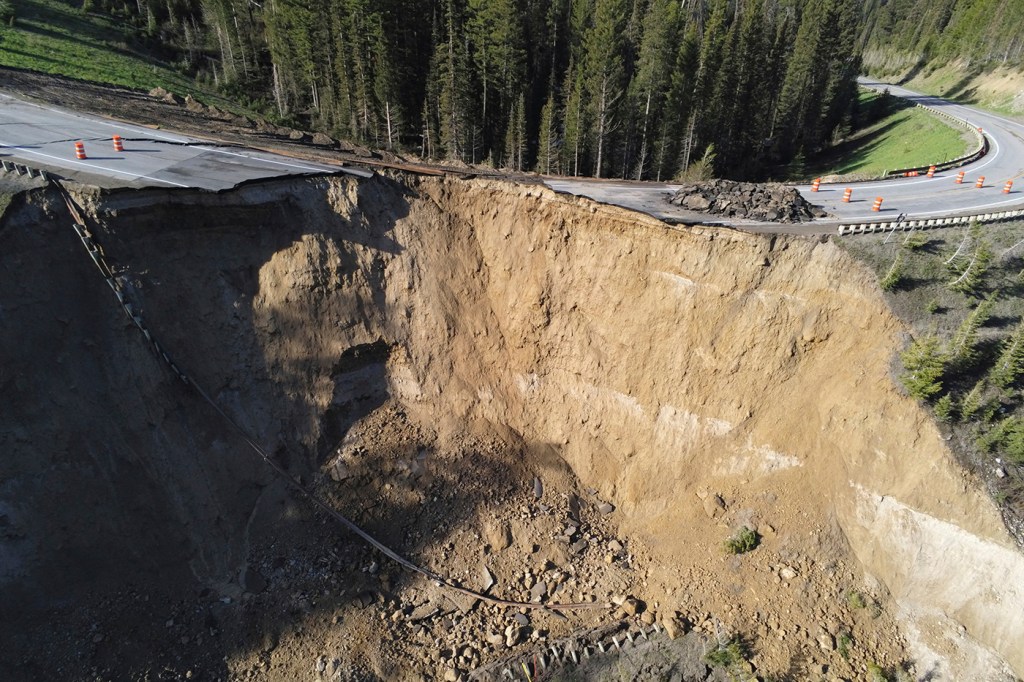A section of critical highway collapsed in Wyoming. Could it happen anywhere?
“These failures don’t happen everywhere. The conditions have to be right,” says Craig Shillaber, an associate teaching professor of civil and environmental engineering at Northeastern University.

The partial collapse of a roadway in Wyoming as a result of a landslide that occurred over the weekend raises serious questions about the state of the nation’s infrastructure — echoing concerns aired recently over a range of issues, from frequent water main breaks to the Baltimore bridge collapse in March.
Constructed in 1969, the Teton Pass is a “critical” link between Victor, Idaho, and Jackson, Wyoming. There’s no timeline for the reopening, which could take “weeks to months,” says Daniel Aldrich, director of Northeastern University’s Security and Resilience Program and co-director at the Global Resilience Institute.
Aldrich, who studies resilience and preparedness, says the incident illustrates just how vulnerable the nation’s infrastructure is to catastrophic failure.
“The Teton Pass roadway is one of the few roads connecting these hard-to-reach areas, and for those trying to get to hospitals — this could be one of the only roads possible,” he says.
“We don’t recognize how important these systems are until there is a major issue. We assume the roads are going to work; we assume the bridges are going to work — until they don’t,” Aldrich says.
But these kinds of “slope” failures depend on a number of conditions.
Craig Shillaber, an associate teaching professor of civil and environmental engineering at Northeastern University, says that slope failures, or landslides, typically occur “when the shear stress imposed by a loading condition exceeds the shear strength of the foundation soil.”
Shillaber says it appears that the road is constructed on an embankment, elevating it from the natural ground. “This is common where the natural ground changes elevation rapidly, in order to create a more steady and even slope for traffic on the roadway.”
“These failures don’t happen everywhere. The conditions have to be right,” he says. “For example, you need a road on top of a slope, and then the slope must have a loading that exceeds the shear strength of the foundation soil. That typically happens as a result of changes in water conditions, such as groundwater levels rising higher than anticipated.”
Shillaber adds that sometimes a slope failure is the result of a failure to identify a weak soil layer in the subsurface. “We hear about these types of failures along California’s coastal Highway 1, for example, with some frequency,” he says.
In March, a portion of Highway 1 in California crumbled into the ocean after a chunk of the cliff gave way, stranding some 1,500 motorists.
Much of the nation’s infrastructure, including the highway system, was built in the 1960s. The population has since doubled, creating demands that experts say have pushed the system to its useful limits.
The nation’s infrastructure troubles are well-documented. The American Society of Civil Engineers estimates that, in the U.S., a water main breaks roughly every two minutes. In 2021, the society gave U.S. infrastructure a grade of C-, up out of the D range it had sat it for nearly two decades. (Transit by itself, however, earned an abysmal D-.)
“Growing wear and tear on our nation’s roads have left 43% of our public roadways in poor or mediocre condition, a number that has remained stagnant over the past several years,” the American Society of Civil Engineers said in its last report card.
Featured Posts
The society assesses the nation’s infrastructure every four years.
“We know, generally speaking, that the U.S.’s physical infrastructure isn’t graded well by professionals,” Aldrich says.
He says that elsewhere in the industrialized world, infrastructure “is clearly a higher priority.” In Europe, the Netherlands, Switzerland and Germany consistently outperform their neighbors, according to various infrastructure indices. In Asia, Japan and Singapore lead the way.
From aviation to bridges, roads and rail systems, the U.S. lags behind other advanced economies in terms of “infrastructure quality and spending,” according to the Council on Foreign Relations.
“Japan and Europe do a much better job of aligning the politics of finance with the nitty gritty needs of infrastructure upgrade,” Aldrich says.
The dollar cost to rebuild part of a highway or a collapsed bridge is one thing (and, to be sure, it’s never cheap); but Aldrich stresses that there are real social and economic costs, such as the costs associated with timely health care needs, from emergency services to delayed medical care.
The Teton Pass failure is a good example, he says.
“Part of what needs to change is this cycle of investing in our infrastructure after a shock occurs, rather than before it,” he says. “The boring, uninteresting, not-for-front-page kind of news is: ‘We found a crack in the road and fixed it.’”
No injuries were reported in connection with the Teton Pass landslide.











